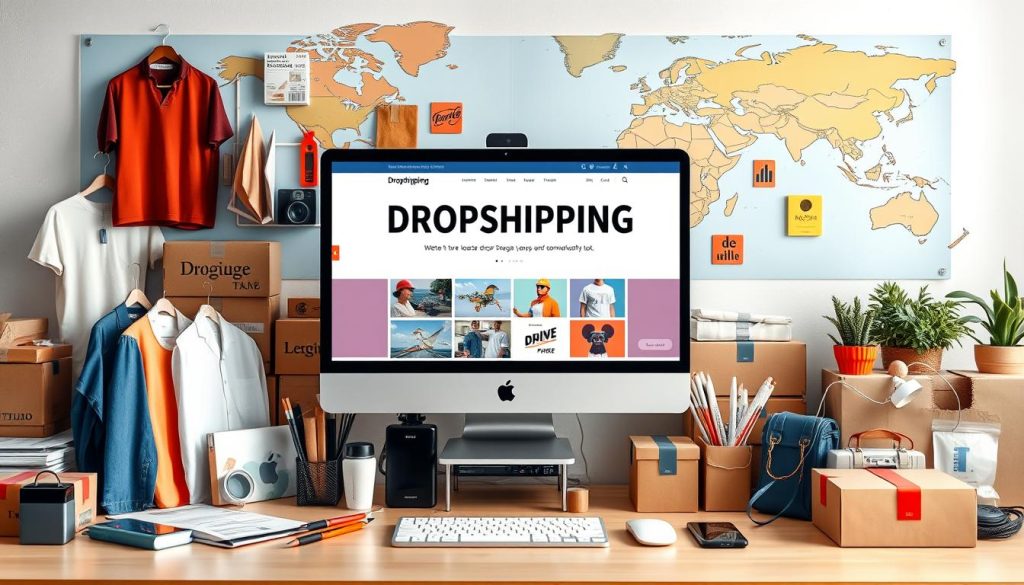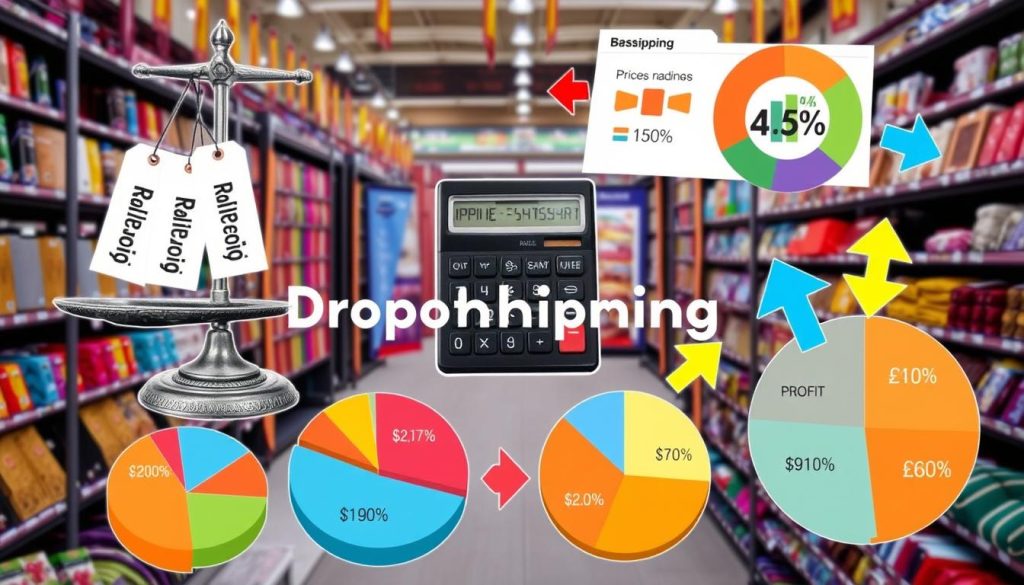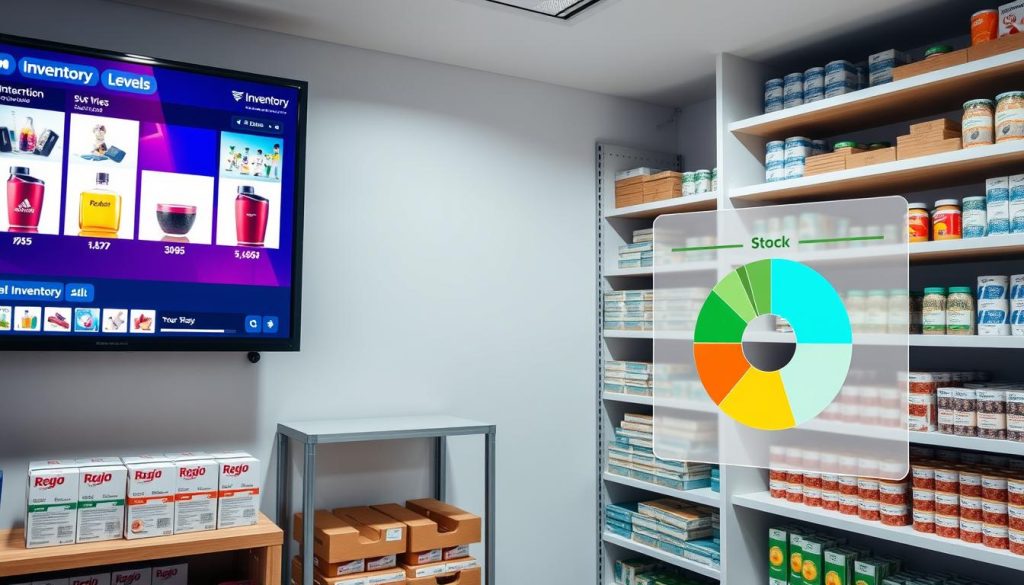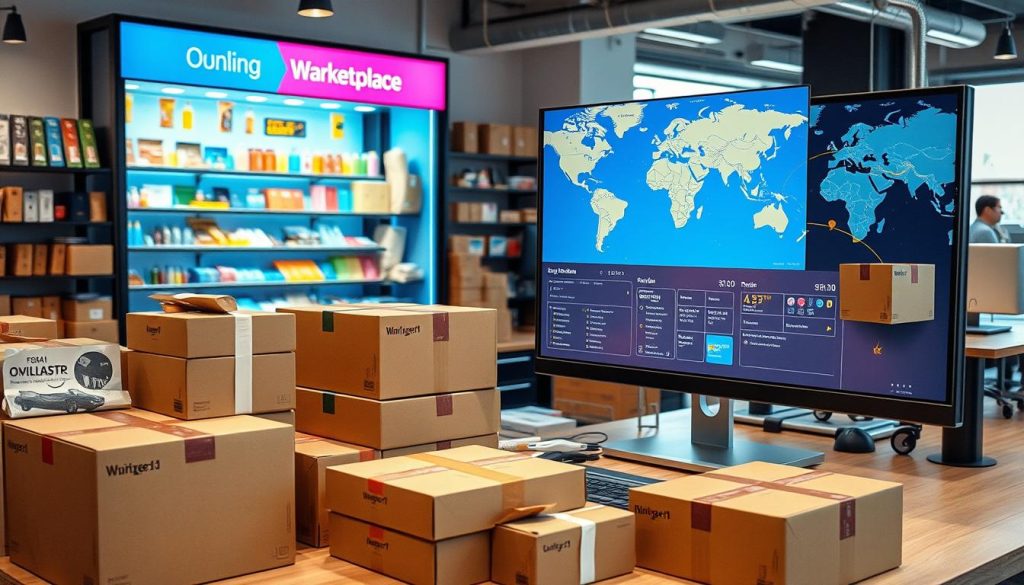In today’s fast-changing e-commerce world, dropshipping has become a popular choice for UK entrepreneurs. It lets retailers sell products without the need to keep stock. This method cuts down on financial risks. It also lets people focus on making their online business a success while being more flexible.
We will look into the key parts of starting a dropshipping business. We’ll see what it takes to do well in this competitive field.
Understanding the Dropshipping Model

The dropshipping model changes how retail works, making it easier for businesses to skip holding inventory. In this model, retailers focus on marketing, sales, and helping customers. They leave managing stock and sending orders to third-party suppliers.
This way, e-commerce businesses can keep their supply chain simple and cut costs on storage and shipping. Products go straight from suppliers to customers, making the process quicker and more efficient. Retailers are key in bringing in customers and making sales.
This model changes how costs and profits work out. It means businesses don’t need to spend a lot upfront. They can try out different products without worrying about having too much stock. This makes dropshipping great for new entrepreneurs and those wanting to improve their supply chain.
Key Benefits of a Dropshipping Business

Starting a dropshipping business has many advantages that draw in new entrepreneurs. It’s key to know these benefits if you’re thinking about joining e-commerce. The main perks include low start-up costs and the ability to grow your business easily.
Low Startup Costs
One big plus of dropshipping is the low cost to begin. You don’t need to spend money upfront on inventory. Without the need for a warehouse or managing lots of stock, costs go down. This makes it easier for people to start their business with little money, which is great for many.
Flexibility and Scalability
Dropshipping offers great flexibility in how you run your business. You can change what you offer based on what customers want, without the usual retail problems. If more people want your products, it’s easy to grow. You can add more products or reach new customers without spending a lot, making it perfect for e-commerce newcomers.
Challenges in the Dropshipping Sector

Dropshipping seems great because it’s cheap to start and flexible. But, there are big challenges. Entrepreneurs face issues with suppliers and customer service that can really affect their success. It’s key to know these problems to do well in dropshipping.
Supplier Reliability
One big challenge is finding reliable suppliers. It’s crucial to pick suppliers you can trust. If not, you could face problems like:
- Stock shortages, resulting in cancelled orders.
- Delayed shipments, leading to dissatisfied customers.
- Inconsistent product quality, impacting brand reputation.
Keeping a good relationship with suppliers helps avoid these issues. Clear communication and setting clear expectations can make things run smoother.
Customer Service Issues
Good customer service is key in retail, but it’s harder in dropshipping. Since you don’t control the delivery, handling customer questions and problems can be tough. Issues include:
- Managing returns efficiently.
- Addressing complaints about product quality or delivery times.
- Providing updates on order status.
Being proactive with customer service can make customers happier and more loyal, even with dropshipping’s challenges.
Choosing the Right Niche for Your Dropshipping Business

Finding the right niche is key to a successful dropshipping business. A good niche affects what products you sell and who you sell to. It’s the first step in starting your business and needs careful market research.
Market research can include looking at trends, reading online forums, or using keyword tools. It helps you see what customers want and find the best product areas. Looking at competitors also shows you which niches are too crowded and which might grow.
Choosing a niche should also think about what you’re interested in and good at. Picking a niche you love keeps you motivated and engaged. It also helps you make marketing that truly speaks to your customers.
- Identify emerging market trends
- Evaluate customer needs and behaviours
- Assess competition within potential niches
- Focus on profitable niches aligned with your interests
Knowing your target market well is crucial for dropshipping success. By picking a niche that’s profitable and interesting to you, you’ll increase your chances of doing well in the online retail world.
Finding Reputable Dropshipping Suppliers

Finding reliable dropshipping suppliers is key to a successful business. Good supplier research helps you find partners who can meet your needs and make customers happy.
Researching Suppliers
There are several ways to research suppliers. Start with online directories like Alibaba and SaleHoo. These sites are great for finding potential suppliers.
Going to trade shows is another good idea. It lets you meet suppliers face-to-face and check out their products. Reading reviews and testimonials can also give you a good idea of a supplier’s reliability and quality of service.
Establishing Relationships
Building strong partnerships with suppliers is vital for long-term success. Good communication builds trust and makes sure everyone knows what to expect. Keeping in touch through calls or emails helps keep the relationship strong.
Working out terms that are good for both you and your suppliers makes for a smooth working relationship. This helps improve customer satisfaction.
Setting Up Your Online Store

Setting up your online store is key to a successful dropshipping business. The right e-commerce platform makes creating your website easy and professional. With many options out there, picking the right one is crucial.
Choosing the Right E-commerce Platform
There are many e-commerce platforms, each with its own set of features. Some top choices are:
- Shopify: It’s easy to use and has a wide range of apps, making it great for all-in-one solutions.
- WooCommerce: This is a WordPress plugin that gives you lots of control, perfect for those who know WordPress well.
- BigCommerce: It’s made for businesses that are growing, handling lots of products with extra features to boost your site.
Think about the costs of each platform, like transaction fees and monthly fees. A good online store setup also means making your website look great. How it looks and how easy it is to use affects how many customers buy from you.
Marketing Strategies for Your Dropshipping Business

Effective marketing is key to a successful dropshipping business. It boosts brand awareness and sales. Using social media and SEO is crucial.
Utilising Social Media
Facebook, Instagram, and Pinterest are great for dropshipping marketing. They let you connect with potential customers directly. This builds loyalty to your brand. Here are some tips:
- Make posts that look good and show off your products.
- Talk to followers by replying to comments and messages.
- Use paid ads to reach more people.
- Work with influencers to get your products seen by more people.
Search Engine Optimisation Techniques
Getting your website to show up in search results is important. SEO helps you stand out in a crowded market. Here’s what to do:
- Find keywords that fit your products.
- Write content that answers customer questions.
- Make sure your meta tags and descriptions help with search rankings.
- Get links from trusted websites to boost your site’s authority.
The Importance of Pricing Strategies

In dropshipping, the right pricing is key to making profits and selling more. Choosing the best price means knowing what makes you stand out in the market.
There are different ways to price your products, each with its own benefits. Competitive pricing means setting prices as low or lower than others to draw in customers. But, it can also mean smaller profits if not watched closely.
- Cost-plus pricing: This method adds a markup to the total cost of goods sold to make a profit. It’s simple but needs accurate cost tracking to avoid wrong pricing.
- Value-based pricing: This strategy sets prices based on what customers value, leading to bigger profits if the product offers great benefits.
Finding the right balance between price and profit is essential. A focus on pricing helps dropshipping businesses stay ahead and increase profits. Knowing the market and what customers want helps make smart pricing choices in a fast-changing world.
Dropshipping Business: Legal Considerations

Running a dropshipping business in the UK means knowing the law well. It’s key to avoid issues that could harm your business. You need to understand about registering your business and following UK tax laws. These are vital for a legal and successful business.
Business Registration
Getting your business registered is crucial for UK law compliance. You can choose to be a sole trader, partner, or a limited company. Each option affects how you’re legally responsible and what taxes you pay. Also, you’ll need the right licenses and permits for your products. Not following these rules can cause legal problems and slow down your business.
Tax Obligations in the UK
Knowing your tax duties is key to running a dropshipping business. You must register for VAT if your sales go over the VAT limit. It’s important to follow UK tax laws and pay taxes on time to avoid fines. Keeping good records of your sales and costs is also crucial for tax and smooth business running.
Effective Inventory Management in Dropshipping

Managing stock well is key to a dropshipping business’s success. It affects how happy customers are and how much money the business makes. By using the right tools, retailers can keep up with demand and avoid running out of stock or having too much.
Using advanced inventory management software helps businesses to:
- Keep track of stock levels in real-time, giving customers the right info.
- Guess demand better, making sure they have enough stock for customers.
- Automate ordering, reducing the chance of running out of stock.
Real-time updates on stock levels are very important. They make customers happy by stopping the problem of ordering items that aren’t there. Keeping the supply chain smooth helps avoid delays and keeps customers updated on their orders.
In summary, managing stock well is essential for a dropshipping business to do well. Focusing on stock control builds trust with customers and helps increase sales.
Shipping and Fulfilment Best Practices

For any dropshipping business, it’s key to have good shipping strategies to make customers happy. Picking the right shipping providers is very important. Companies like DHL, UPS, and Royal Mail offer many services for different delivery needs.
It’s also vital to have efficient ways to handle orders. Businesses should think about:
- Making order processing faster for quicker deliveries.
- Using automation tools to make tasks like tracking orders and managing stock easier.
- Working with several carriers to give customers more shipping choices.
It’s important to be clear about when things will arrive. Businesses should give honest estimates and tell customers about any delays. Being open about shipping can make customers more satisfied and loyal.
Using these best practices in shipping and handling orders will make things run smoother. It will also make shopping a better experience for customers.
Building a Strong Brand in the Dropshipping Industry

In the dropshipping world, having a strong brand is key for lasting success. A clear brand identity sets you apart from others, making you stand out to customers. It starts with knowing what makes you special and sharing your brand’s values.
Good branding means having a consistent message everywhere, building trust and loyalty. Make sure your look, voice, and ads match your brand. This makes your brand feel real and trustworthy to customers. People like to come back to brands that share their values and meet their needs.
- Define your brand mission and vision.
- Create a unique logo and visual elements that reflect your brand identity.
- Develop engaging content that tells your brand story.
- Utilise social media to connect with your audience and promote brand awareness.
- Gather customer feedback to refine your branding strategies continually.
Using these steps will boost your brand and help keep customers coming back. A strong brand makes customers feel part of something special, making them pick your products over others. Putting effort into branding is a smart move for long-term success in dropshipping.
Analysing Performance and Metrics

In any dropshipping business, it’s key to keep an eye on how things are doing. Knowing and using key performance indicators (KPIs) and business metrics is crucial. This helps make better decisions and opens up new growth chances.
Understanding Key Performance Indicators (KPIs)
Understanding important KPIs can really change your dropshipping game. Things like conversion rates, average order value, and customer acquisition cost give you a peek into your business’s health. By looking closely at these, you can spot trends and see where you need to focus.
- Conversion Rates: This shows how many visitors turn into buyers. By tracking this, you can find out what marketing works best and make your website better for customers.
- Average Order Value: This tells you how much each order is worth on average. Boosting this can increase your revenue without bringing in more visitors.
- Customer Acquisition Cost: This is the cost of getting a new customer. Keeping an eye on this makes sure you’re spending wisely and making enough from new customers.
These KPIs are essential for checking how your dropshipping business is doing. They help entrepreneurs tweak their plans and grow steadily in a tough market.
Expanding Your Dropshipping Business

Once your dropshipping business starts to grow, looking into ways to expand can make it more profitable. Using smart growth strategies helps you reach more people and grow your market share. Here are some key strategies to think about:
- Adding more products can draw in new customers and keep the old ones happy. By offering more items or getting into what’s currently popular, you could make more money.
- Finding new customers means looking at groups that like your products. Making your marketing speak to these groups can really help.
- Using more sales channels like Amazon, eBay, or social media can make you more visible. This way, you reach different types of customers and grow your market share.
- Using analytics tools to keep an eye on how customers interact with your store and what sells best. This info helps you make smarter choices to meet what the market wants.
By focusing on these strategies, an established dropshipping business can overcome challenges and grow. This leads to a stronger market presence.
Future Trends in the Dropshipping Market
The dropshipping market is set to change a lot in the future. This change will come from new technology and how people shop. Things like artificial intelligence, automation, and data analytics will change how we manage stock and talk to customers. These changes will make things more efficient and improve how customers feel, which is key to staying ahead.
New markets and different types of customers will also shape the future of dropshipping. E-commerce is growing fast in new places, offering chances for dropshippers to find new customers. Those who adapt to local tastes and use mobile shopping will do well. Knowing about these changes will help businesses stay relevant and grow.
Now, more people care about the environment and where their stuff comes from. Brands that are green and open about their supply chains might get more loyal customers. Dropshipping businesses need to think about these values to gain trust and grow over time. By keeping up with these trends, dropshipping entrepreneurs can be ready for a bright future in online shopping.
















